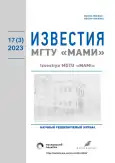The method of considering the efficiency of flow compartments of multi-stage turbines when calculating energy characteristics
- Authors: Gubarev A.Y.1
-
Affiliations:
- Samara State Technical University
- Issue: Vol 17, No 3 (2023)
- Pages: 225-232
- Section: Combined power plants
- URL: https://journals.eco-vector.com/2074-0530/article/view/375265
- DOI: https://doi.org/10.17816/2074-0530-375265
- ID: 375265
Cite item
Abstract
BACKGROUND: Modern methods of calculating energy characteristics of steam turbine units (STU) are based on development of digital models. Considering this, the main components of the STU’s model is a model of a multistage turbine.
AIMS: Improvement of existing methods of calculating energy characteristics taking into account influence of efficiency of flow compartments.
METHODS: Results of the studies dealing with new methods of development of energy characteristics of multi-stage turbines are presented in the article. In particular, the new method of considering the influence of changing the efficiency of flow compartments of multi-stage turbines depending on working body flow rate is proposed. The method of calculation of turbine energy characteristics is given. The proposed method is based on development of the model of a turbine unit taking into account changing of technical and economic performance of its specific elements depending on the load.
RESULTS: Results of theoretical justification of a non-linear dependency of turbine flow compartments’ power on working body flow rate based on changing internal efficiency of stages at variable modes described with the Stodola-Fluegel equation are given in the article.
Based on the solution of the Stodola-Fluegel equation, the equation for vane efficiency and the equation of isentropic heat drop, the dependence of flow compartment’s operation efficiency on relative working body flow rate is obtained. The advice for using it when modelling turbines is given.
The analysis of the experimental data obtained at the testing of the PT-60-130/13 steam turbine was carried out. Experimental dependency of the stages’ efficiency on steam flow rate are presented. It is established that the proposed dependency of internal efficiency of turbines’ flow compartments complies with the theoretical and experimental data in a good quality and can be used in calculation of energy characteristics and modelling.
As a practical value of the study, the model of the PT-60-130/13 turbine unit was developed. The mode diagram built with the use of the model and complying with the heat testing results is given.
CONCLUSIONS: The developed model of the turbine unit helps to simulate any operation mode depending on electric and heat loads. In addition, with the use of the model, it is possible to take into account the influence of deviation of external factors from nominal values at development of the system of correction or estimation of fuel consumption increase related to these deviations.
Full Text
About the authors
Anton Y. Gubarev
Samara State Technical University
Author for correspondence.
Email: gubarev_a_y@mail.ru
ORCID iD: 0000-0003-1533-0435
SPIN-code: 6739-0299
Cand. Sci. (Tech.), Associate Professor of the Thermal Power Plants Department
Russian Federation, SamaraReferences
- Kostyuk AG, Frolov VV, Bulkin AE, et al. Steam and gas turbines for power plants: a textbook for universities. Moscow: Izdatelskiy dom MEI; 2016. (in Russ).
- MU 34-70-093-84 Metodicheskie ukazaniya po teplovym ispytaniyam parovykh turbin. M.: SOYuZTEKhENERGO, 1986. (in Russ). Accessed: 26.04.2023. Available from: https://files.stroyinf.ru/Data2/1/4294812/4294812875.htm
- Leduhovsky GV, Pospelov AA, Zorin MYu, et al. Experimental determination of the grid of corrections to the power of the Tp-115/125-130-1TP UTMZ turbine for the deviation of the exhaust steam pressure in the condenser. Vestnik IGEU. 2010;4:4–9. (in Russ).
- Ledukhovsky GV, Pospelov AA, Astashov NS, et al. Testing of the turbine unit Tp-115/125-130-1TP PO TMZ when operating in district heating mode with two-stage heating of network water in order to construct a mode diagram. Vestnik IGEU. 2011;2:3–10. (in Russ).
- Bubnov KN, Barochkin AE, Zhukov VP, et al. Taking into account the efficiency of the flow sections of turbine units in the computational analysis of their energy characteristics. Vestnik IGEU. 2019;3:62–68. (in Russ).
- Barochkin AE, Zhukov VP, Barochkin EV, et al. Matrix representation of the model of the thermal circuit of an electric station. Vestnik IGEU. 2018;6:66–72. (in Russ).
- Shcheglyaev AV. Steam turbines. Moscow: Energiya; 1967. (in Russ).
- Bubnov KN, Barochkin AE, Zhukov VP, et al. Methodology for calculating the energy characteristics of a heating turbine taking into account the efficiency of the low pressure part. Vestnik IGEU. 2020;2: 5–13.(in Russ).
- Ilichev VY, Yurik EA. Development of methodology for calculation of optimal distribution of electric power between power units of condensing power plant. Izvestiya MGTU MAMI. 2021;15(2):18–25. (in Russ). doi: 10.31992/2074-0530-2021-48-2-18-25
- Kultyshev AY, Stepanov MY, Linder TY. Diagrams of regimes of cogeneration steam turbines for combined-cycle power plants. Thermal Engineering. 2012;59(12):913–918. doi: 10.1134/S0040601512120051
- Tatarinova NV, Suvorov DM, Sushikh VM. Mathematical models of cogeneration steam turbine plants based on experimental characteristics of turbine stages and compartments. Nadezhnost i bezopasnost energetiki. 2017;10(4):330–339. (in Russ).
- Tatarinova NV, Sushikh VM. Study of flow and power characteristics of the last sections of cogeneration steam turbines. Problemy regionalnoy energetiki. 2019;3(44):79–90. (in Russ). doi: https://doi.org/10.5281/zenodo.3562205
- Trukhniy AD. Combined-cycle power plants: a textbook for universities. Moscow: Izdatelskiy dom MEI; 2013. (in Russ).
- Gubarev AY, Kudinov AA, Eremin AV, et al. Application of a small deviation method in the study of the influence of external factors on gas turbine unit operation. J. Phys.: Conf. Ser. 2020;1683:042006. doi: 10.1088/1742-6596/1683/4/042006
Supplementary files












